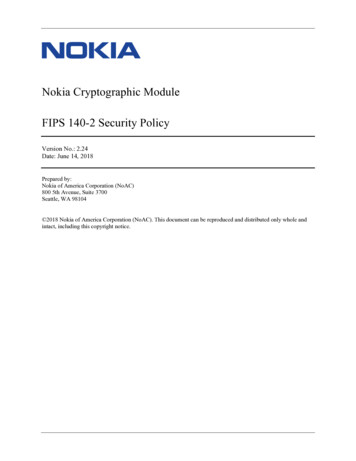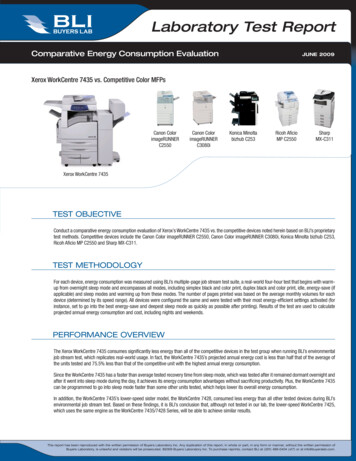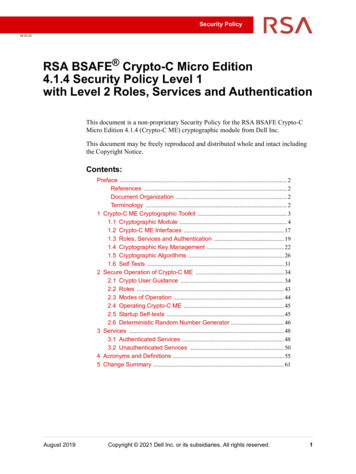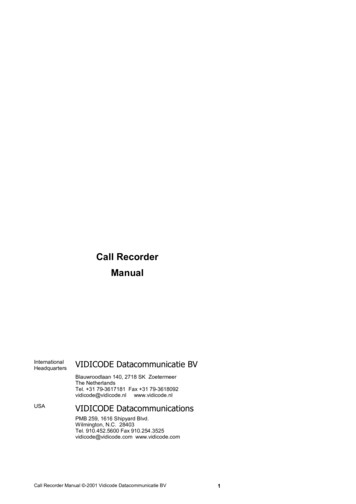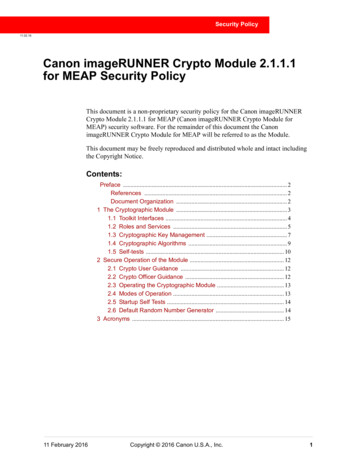
Transcription
Security Policy11.02.16Canon imageRUNNER Crypto Module 2.1.1.1for MEAP Security PolicyThis document is a non-proprietary security policy for the Canon imageRUNNERCrypto Module 2.1.1.1 for MEAP (Canon imageRUNNER Crypto Module forMEAP) security software. For the remainder of this document the CanonimageRUNNER Crypto Module for MEAP will be referred to as the Module.This document may be freely reproduced and distributed whole and intact includingthe Copyright Notice.Contents:Preface . 2References . 2Document Organization . 21 The Cryptographic Module . 31.1 Toolkit Interfaces . 41.2 Roles and Services . 51.3 Cryptographic Key Management . 71.4 Cryptographic Algorithms . 91.5 Self-tests . 102 Secure Operation of the Module . 122.1 Crypto User Guidance . 122.2 Crypto Officer Guidance . 122.3 Operating the Cryptographic Module . 132.4 Modes of Operation . 132.5 Startup Self Tests . 142.6 Default Random Number Generator . 143 Acronyms . 1511 February 2016Copyright 2016 Canon U.S.A., Inc.1
Canon imageRUNNER Crypto Module 2.1.1.1 for MEAP Security PolicyPrefaceThis document is a non-proprietary security policy for the Canon imageRUNNERCrypto Module for MEAP. This security policy describes how the Module meets thesecurity requirements of FIPS 140-2, and how to securely operate it. This policy isprepared as part of the Level 1 FIPS 140-2 validation of the Module.FIPS 140-2 (Federal Information Processing Standards Publication 140-2 - SecurityRequirements for Cryptographic Modules) details the U.S. Government requirementsfor cryptographic modules. More information about the FIPS 140-2 standard andvalidation program is available on the NIST website.ReferencesThis document deals only with operations and capabilities of the Module in thetechnical terms of a FIPS 140-2 cryptographic toolkit security policy.Document OrganizationThis Security Policy document is one document in the FIPS 140-2 ValidationSubmission package. With the exception of the Non-Proprietary CanonimageRUNNER Crypto Module for MEAP Security Policy, the FIPS 140-2 ValidationSubmission Documentation is RSA Security-proprietary and is releasable only underappropriate non-disclosure agreements. For access to the documentation, pleasecontact Canon U.S.A Inc.This document explains the Module’s features and functionality relevant to FIPS140-2, and contains the following sections:2 This section, “Preface” on page 2 provides an overview and introduction to theSecurity Policy. “The Cryptographic Module” on page 3, describes the Module and how it meetsthe FIPS 140-2 requirements. “Secure Operation of the Module” on page 12, provides information onimplementing the FIPS mode of operation. “Acronyms” on page 15, lists the definitions for the acronyms used in thisdocument.Preface
Canon imageRUNNER Crypto Module 2.1.1.1 for MEAP Security Policy1 The Cryptographic ModuleThe Module is classified as a FIPS 140-2 multi-chip standalone module. As such, theModule is tested on particular operating systems and computer platforms. Thecryptographic boundary includes the Module running on selected platforms that arerunning selected operating systems, while configured in single user mode.The Module is validated for all FIPS 140-2 Level 1 security requirements. It ispackaged in a Java Archive (JAR) file containing all the code for the toolkit. Inaddition, the Module relies on the physical security provided by the host on which itruns.The Module is provided in the cryptoCDCFIPS.jar file.The Module is tested on the following platform: Canon imageRUNNER with MEAP SDK 4.60 SP4 and CDC 1.1 FoundationProfile 1.1 with optional JCE provider package.The Cryptographic Module3
Canon imageRUNNER Crypto Module 2.1.1.1 for MEAP Security Policy1.1 Toolkit InterfacesAs a multi-chip standalone toolkit, the physical interface to the Module consists of akeyboard, mouse, monitor, serial ports and network adapters.The underlying logical interface to the toolkit is the API, documented in the RSABSAFE TLS-J ME Javadoc. The Module provides for Control Input through the APIcalls. Data Input and Output are provided in the variables passed with API calls, andStatus Output is provided in the returns and error codes documented for each call. Thisis shown in the following diagram.ApplicationData InData OutControl InStatus OutCryptographic BoundaryCryptographic ModulecryptoCDCFIPS.jarProvides services forModuleRuns on JVMJava Virtual Machine (JVM)Provides services forJVMRun on OSOperating System (OS)SoftwareRuns on HardwareProvides service for OSHardwareHardwareFigure 1 Logical Diagram4The Cryptographic Module
Canon imageRUNNER Crypto Module 2.1.1.1 for MEAP Security Policy1.2 Roles and ServicesThe Module meets all FIPS140-2 Level 1 requirements for Roles and Services,implementing both a Crypto Officer role and a Crypto User role. As allowed by FIPS140-2, the Module does not require user identification or authentication for theseroles.1.2.1 Crypto Officer RoleThe Crypto Officer role is responsible for installation of the toolkit. An operator canassume the Crypto Officer role by instantiating the CryptoProvider class withcom.rsa.jme.FIPS140Context.OFFICER FIPS140 orcom.rsa.jme.FIPS140Context.OFFICER FIPS140 SSL as a parameter.The Crypto Officer is provided with all the services available to the Crypto User (seesection 2.4.2). In addition, the Crypto Officer can explicitly re-execute the power-upself-tests after the toolkit has been loaded. This can be done using thecom.rsa.jme.CryptoModule.FIPS140.runSelfTests method withFIPS140Context.OFFICER FIPS140 orFIPS140Context.OFFICER FIPS140 SSL as the argument.Note: When the Module is loaded and configured for FIPS140-2 use, thepower-up self tests run automatically. If theCryptoModule.FIPS140.runSelfTests method is invoked after thetoolkit is loaded, all power-up tests will be re-executed.1.2.2 Crypto User RoleThe Crypto User role is the default operating role. An operator can explicitly assumethe Crypto User role by instantiating the CryptoProvider class with no parameters,or with com.rsa.jme.FIPS140Context.USER FIPS140 orcom.rsa.jme.FIPS140Context.USER FIPS140 SSL as a parameter.The Cryptographic Module5
Canon imageRUNNER Crypto Module 2.1.1.1 for MEAP Security Policy1.2.3 ServicesThe following table details the services provided by the Module in terms of the toolkitinterface.Table 1Role for Authorized ServicesAuthorized 42DHPrivateKeySpec.javaX942DHPublicKeySpec.javaThe Cryptographic Module
Canon imageRUNNER Crypto Module 2.1.1.1 for MEAP Security Policy1.3 Cryptographic Key Management1.3.1 Key GenerationThe Module supports the generation of the DSA, RSA, and ECDSA public and privatekeys. The toolkit also employs a FIPS-approved HMAC Deterministic Random BitGenerator (HMAC DRBG SP800-90A) for generating asymmetric and symmetrickeys used in algorithms such as AES, Triple-DES, RSA, DSA, and ECDSA.1.3.2 Key ProtectionAll key data resides in internally allocated data structures and can only be output usingthe Module’s API. The operating system and the Java Runtime Environment (JRE)protects memory and process space from unauthorized access.1.3.3 Key AccessAn authorized operator of the Module has access to all key data created during theoperation of the Module.Note: The User and Officer roles have equal and complete access to all keys.The following table lists the different services provided by the toolkit with the type ofaccess to keys or Critical Security Parameters (CSPs).Table 2Key and CSP AccessServiceKey or CSPType of AccessEncryption and decryptionSymmetric keys (AES and Triple-DES)Read/ExecuteDigital signature andverificationAsymmetric keys (DSA, RSA, and ECDSA)Read/ExecuteHashingNoneN/AMACHMAC keysRead/ExecuteRandom number generationHMAC DRBG Entropy, V Value, Key, and init seedRead/Write/ExecuteKey establishment primitivesAsymmetric keys (RSA), KDF CTR, and KDF X9.63Read/ExecuteKey generationSymmetric keys (AES and Triple-DES)Asymmetric keys (DSA, ECDSA, and RSA)MAC keys (HMAC)WriteSelf-test (only available toCrypto Officer service)Hardcoded keys(AES, Triple-DES, RSA, DSA, ECDSA and HMAC)Read/ExecuteShow statusNoneN/AZeroizationAllRead/WriteThe Cryptographic Module7
Canon imageRUNNER Crypto Module 2.1.1.1 for MEAP Security Policy1.3.4 Key ZeroizationUsers can ensure sensitive data is properly zeroized by making use of theSensitiveData.clearSensitiveData method for clearing sensitive data. Thetoolkit ensures that all ephemeral sensitive data is cleared within the toolkit.1.3.5 Key StorageThe Module does not provide long-term cryptographic key storage. Storage of keys isthe responsibility of the user of the Module.The following table shows how the storage of keys and CSPs are handled. The CryptoUser and Crypto Officer roles have equal and complete access to all keys and CSPs.Table 38Key and CSP StorageItemStorageAES keysIn volatile memory only (plaintext)Triple-DES keysIn volatile memory only (plaintext)HMAC with SHA1 and SHA2 keysIn volatile memory only (plaintext)ECDSA public keysIn volatile memory only (plaintext)ECDSA private keysIn volatile memory only (plaintext)RSA public keyIn volatile memory only (plaintext)RSA private keyIn volatile memory only (plaintext)DSA public keyIn volatile memory only (plaintext)DSA private keyIn volatile memory only (plaintext)HMAC DRBG EntropyIn volatile memory only (plaintext)HMAC DRBG V ValueIn volatile memory only (plaintext)HMAC DRBG KeyIn volatile memory only (plaintext)HMAC DRBG init seedIn volatile memory only (plaintext)HMAC Integrity Test KeyIn Module JAR file (plaintext)The Cryptographic Module
Canon imageRUNNER Crypto Module 2.1.1.1 for MEAP Security Policy1.4 Cryptographic AlgorithmsThe Module meets FIPS 140-2 requirements by implementing algorithm enforcement,such that when operating in FIPS140 MODE, only FIPS 140-approved algorithms areavailable for use.The following table lists the FIPS 140-approved algorithms provided by the Module,when operating in FIPS140 MODE.Table 4FIPS-approved Algorithms in the ModuleAlgorithmValidation CertificateAES in ECB, CBC, CCM, and CMAC modeCertificate #3442AES key wrap (SP800-38F) - KW (AE, AD, AES-128, AES-192, and AES-256)Certificate #3442AES in GCM mode with automatic Initialization Vector (IV) generationCertificate #3442Triple-DES in ECB and CBC modeCertificate #1939Triple-DES key wrapNon-approved (Allowed inFIPS mode)DSACertificate #969Note: Key size of 1024 bits can only be used for verification.1EC-DSA and EC-DSA-SHA1Certificate #694HMAC DRBG (SP800-90A)Certificate #840HMAC-SHA1, SHA224, SHA256, SHA384, and SHA512Certificate #2191KDF CTR (SP800-108)Certificate #60KDF X9.63 (SP800-135)CVL Certificate #528RSA key wrapNon-approved(Allowed in FIPS mode forkey transport)NDRNG (Timer-based entropy)Non-approved(Allowed in FIPS mode)RSA X9.31, PKCS #1 V.1.5, PKC S#1 V.2.1, and RSASSA-PSSNote: Key size of 1024 bits can only be used forSHA-1 and SHA-224, 256, 384, and 512Certificate #1763verification.1Certificate #28421Key size restriction as per SP800-131A.The Cryptographic Module9
Canon imageRUNNER Crypto Module 2.1.1.1 for MEAP Security PolicyThe following list contains the non-FIPS 140-approved algorithms provided by theModule, when operating in NON FIPS140 MODE. DES ECIES MD4 MD5 PBE RC2 block cipher RC4 stream cipher RSA OAEP for key transport Raw RSA (encrypt/decrypt) HMAC-MD5 FIPS 186-2 PRNG Diffie-Hellman (DH) primitives EC-DH and EC-DH with Cofactor primitives.1.5 Self-testsThe Module performs power-up and conditional self-tests to ensure proper operation.If the power-up self-test fails, the toolkit is disabled and throws aSecurityException. The toolkit can only leave the disabled state by restarting theJVM. If the conditional self-test fails, the toolkit throws a SecurityException andaborts the operation. A conditional self test failure does not disable the toolkit.1.5.1 Power-up Self-testsThe following power-up self-tests are implemented in The Module:10 FIPS186 PRNG KAT AES encrypt/decrypt KAT AES GCM encrypt/decrypt KAT AES CCM encrypt/decrypt KAT AES CMAC KAT AES key wrap encrypt/decrypt KAT KDF X9.63 KAT KDR CTR KAT Triple-DES encrypt/decrypt KAT SHA-1 KAT SHA-224 KATThe Cryptographic Module
Canon imageRUNNER Crypto Module 2.1.1.1 for MEAP Security Policy SHA-256 KAT SHA-384 KAT SHA-512 KAT MD5 KAT HMAC SHA-1 KAT HMAC SHA-224 KAT HMAC SHA-256 KAT HMAC SHA-384 KAT HMAC SHA-512 KAT HMAC DRBG Self-Test ECDSA KAT DSA KAT DSA, RSA, ECDSA pair-wise consistency test RSA (signature) KAT Software integrity check.Power-up self-tests are executed automatically when the Module is loaded into memory.1.5.2 Conditional Self-testsThe Module performs two conditional self-tests: Pair-wise consistency tests each time the toolkit generates a DSA, RSA orECDSA public/private key pair. Continuous RNG (CRNG) test each time the toolkit produces random data, as perthe FIPS 140-2 standard. The CRNG test is performed on all approved and nonapproved PRNGs (HMAC DRBG).1.5.3 Mitigation of Other AttacksRSA key operations implement blinding. Blinding is a reversible way of modifyingthe input data, so as to make the RSA operation immune to timing attacks. Blindinghas no effect on the algorithm other than to mitigate attacks on the algorithm. Blindingvalues are squared for each operation.The Cryptographic Module11
Canon imageRUNNER Crypto Module 2.1.1.1 for MEAP Security Policy2 Secure Operation of the ModuleThe Module does not require any special configuration to operate in conformance withFIPS 140-2 requirements. The following guidance must be followed, however, toachieve a FIPS mode of operation.2.1 Crypto User GuidanceThe Crypto User must only use algorithms approved for use in a FIPS mode ofoperation, as listed in Table 4, “FIPS-approved Algorithms in the Module,” on page 9.The requirements for using the approved algorithms in a FIPS mode of operation areas follows: The bit-length for a DSA key pair must be 1024 bits. This key size can only beused for verification. Random Number Generators must be seeded with values of at least 160 bits inlength. Bit lengths for an RSA1 key pair must be 1024 (this key size can only be used forverification), 2048 or 3072. Bit lengths for an HMAC key must be one half of the block size. If RSA key generation is requested in FIPS mode, the toolkit always uses theFIPS140-approved RSA X9.31 key-generation procedure. Key wrappingmethodology provides between 112 and 128 bits of encryption strength. When using an Approved RNG to generate keys, the RNG's requested securitystrength must be at least as great as the security strength of the key beinggenerated.More information on the algorithm strength and key size is provided in theRSA BSAFE TLS-J ME Release Notes.Users should take care to zeroize CSPs when they are no longer needed.2.2 Crypto Officer GuidanceThe Crypto Officer is responsible for installing the toolkit. Installation instructions areprovided in the 4A-TLS-J ME Installation Guide.When operating the toolkit after installation, the Crypto Officer must follow theCrypto User guidance requirements detailed in section 2.1.1When used for transporting keys and using the minimum allowed modulus size, the minimum strengthof encryption provided is 112 bits.12Secure Operation of the Module
Canon imageRUNNER Crypto Module 2.1.1.1 for MEAP Security Policy2.3 Operating the Cryptographic ModuleThe Module operates in FIPS140 MODE by default. When using the Module in thisFIPS approved mode, the Module ensures that only the FIPS approved algorithmslisted in “Services” on page 6 are available to operators.The Service CryptoModule.FIPS140.runSelfTests() is restricted tooperation by the Crypto Officer.2.4 Modes of OperationThere are three modes of operation: FIPS140 MODE FIPS140 SSL MODE NON FIPS140 MODE.The following table lists the available modes, and the algorithms available in thosemodes. Cryptographic algorithms can be created in different modes using theassociated com.rsa.jme.FIPS140Context instance to instantiate aCryptoProvider object. For more information about operating in FIPS modes, seethe RSA BSAFE TLS-J ME Javadoc.Table 5Mode Value to Change the Mode of OperationMode ValueAlgorithms AvailableFIPS140Context.MODE FIPS140Provides the cryptographic algorithms listed inTable 4,“FIPS-approved Algorithms in the Module,” on page 9. This isthe default mode on start up.FIPS 140-2 approved.FIPS140Context.MODE FIPS140 SSL Provides the same algorithms asFIPS 140-2 approved if used with TLSFIPS140Context.MODE FIPS140, plus the MD5 messageprotocol implementations.digest.This mode can be used in the context of the key establishmentphase in the TLSv1, TLSv1.1 and TLSv1.2 protocols. For moreinformation, see section 7.1 Acceptable Key EstablishmentProtocols in Implementation Guidance for FIPSPUB 140-2 and the Cryptographic ModuleValidation Program.The implementation guidance disallows the use of the SSLv2 andSSLv3 versions. Cipher suites that include non-FIPS140-2-approved algorithms are unavailable.This mode allows implementations of the TLS protocol to operatethe Module in a FIPS 140-2-compliant manner.Note: The TLS protocol was not reviewed or tested by the CAVPor CMVP.FIPS140Context.MODE NON FIPS140 Allows users to operate the Module without any cryptographicNot FIPS 140-2 approved.Secure Operation of the Modulealgorithm restrictions.13
Canon imageRUNNER Crypto Module 2.1.1.1 for MEAP Security Policy2.5 Startup Self TestsAll KATs are executed on toolkit start-up, which occurs on first use. If any KAT fails,the toolkit is disabled.2.6 Default Random Number GeneratorThe Module provides a default RNG, which is HMAC-DRBG, with 128-bit security,using SHA-256.14Secure Operation of the Module
Canon imageRUNNER Crypto Module 2.1.1.1 for MEAP Security Policy3 AcronymsThe following table lists the acronyms used in this document and their definitions.Table 6Acronyms and DefinitionsAcronymDefinitionAESAdvanced Encryption Standard. A fast block cipher with a 128-bit block, and keys oflengths 128, 192 and 256 bits. This will replace DES as the US symmetric encryptionstandard.APIApplication Programming Interface.AttackEither a successful or unsuccessful attempt at breaking part or all of a cryptosystem.Attack types include an algebraic attack, birthday attack, brute force attack, chosenciphertext attack, chosen plaintext attack, differential cryptanalysis, known plaintextattack, linear cryptanalysis, middleperson attack and timing attack.CBCCipher Block Chaining. A mode of encryption in which each ciphertext depends uponall previous ciphertexts. Changing the Initialization Vector (IV) alters the ciphertextproduced by successive encryptions of an identical plaintext.CRNGContinuous Random Number Generation.CSPCritical Security Parameters.DESData Encryption Standard. A symmetric encryption algorithm with a 56-bit key.Diffie-HellmanThe Diffie-Hellman asymmetric key exchange algorithm. There are many variants,but typically two entities exchange some public information (for example, public keysor random values) and combines them with their own private keys to generate a sharedsession key. As private keys are not transmitted, eavesdroppers are not privy to all ofthe information that composes the session key.DRBGDeterministic Random Bit Generator.DSADigital Signature Algorithm. An asymmetric algorithm for creating digital signatures.ECElliptic Curve.ECBElectronic Code Book. A mode of encryption in which identical plaintexts areencrypted to identical ciphertexts, given the same key.ECCElliptic Curve Cryptography.ECDHElliptic Curve Diffie-Hellman.ECDHCElliptic Curve Diffie-Hellman with Cofactor.ECDSAElliptic Curve Digital Signature Algorithm.ECIESElliptic Curve Integrated Encryption Scheme.Acronyms15
Canon imageRUNNER Crypto Module 2.1.1.1 for MEAP Security PolicyTable 6Acronyms and DefinitionsAcronymDefinitionEncryptionThe transformation of plaintext into an apparently less readable form (calledciphertext) through a mathematical process. The ciphertext may be read by anyonewho has the key that decrypts (undoes the encryption) the ciphertext.FIPSFederal Information Processing Standards.HMACKeyed-Hashing for Message Authentication Code.IVInitialization Vector.Used as a seed value for an encryption operation.JVMJava Virtual Machine.KATKnown Answer Test.KDFKey Derivation Function. Derives one or more secret keys from a secret value, such asa master key, using a pseudo-random function.KeyA string of bits used in cryptography, allowing people to encrypt and decrypt data.Can be used to perform other mathematical operations as well. Given a cipher, a keydetermines the mapping of the plaintext to the ciphertext. Various types of keysinclude: distributed key, private key, public key, secret key, session key, shared key,subkey, symmetric key, and weak key.MD4A message digest algorithm which implements a cryptographic hash function, createdby Rivest.MD5A message digest algorithm which implements a cryptographic hash function with a128-bit hash value, created by Rivest.NDRNGNon-deterministic Random Number Generator.NISTNational Institute of Standards and Technology. A division of the US Department ofCommerce (formerly known as the NBS) which produces security andcryptography-related standards.OSOperating System.PCPersonal Computer.private keyThe secret key in public key cryptography. Primarily used for decryption but also usedfor encryption with digital signatures.PRNGPseudo-random Number Generator.RC2Block cipher developed by Ron Rivest as an alternative to the DES. It has a block sizeof 64 bits and a variable key size. It is a legacy cipher and RC5 should be used inpreference.RC4Symmetric algorithm designed by Ron Rivest using variable length keys (usually 40bit or 128 bit).RNGRandom Number Generator.16Acronyms
Canon imageRUNNER Crypto Module 2.1.1.1 for MEAP Security PolicyTable 6Acronyms and DefinitionsAcronymDefinitionRSAPublic key (asymmetric) algorithm providing the ability to encrypt data and create andverify digital signatures. RSA stands for Rivest, Shamir, and Adleman, the developersof the RSA public key cryptosystem.SHASecure Hash Algorithm. An algorithm which creates a hash value for each possibleinput. SHA takes an arbitrary input which is hashed into a 160-bit digest.SHA-1A revision to SHA to correct a weakness. It produces 160-bit digests. SHA-1 takes anarbitrary input which is hashed into a 20-byte digest.SHA-2The NIST-mandated successor to SHA-1, to complement the Advanced EncryptionStandard. It is a family of hash algorithms (SHA-256, SHA-384 and SHA-512) whichproduce digests of 256, 384 and 512 bits respectively.Triple-DESA symmetric encryption algorithm which uses either two or three DES keys. The twokey variant of the algorithm provides 80 bits of security strength while the three keyvariant provides 112 bits of security strength.Acronyms17
imageRUNNER Crypto Module for MEAP Security Policy, the FIPS 140-2 Validation Submission Documentation is RSA Security-proprietary and is releasable only under appropriate non-disclosure agreements. For access to the documentation, please contact Canon U.S.A Inc. This document explains the Module's features and functionality relevant to FIPS

